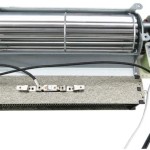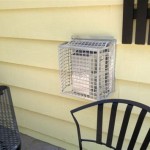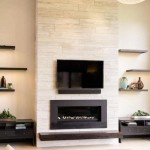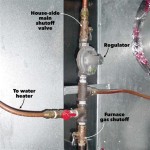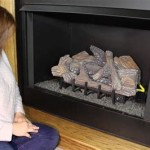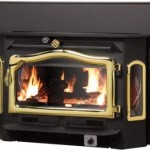Fireplace Ideas with TV Above: Balancing Ambiance and Entertainment
The combination of a fireplace and a television is increasingly common in modern living spaces. Integrating these two focal points requires careful consideration of aesthetics, functionality, and safety. Balancing the ambiance of a fire with the practicality of a television necessitates thoughtful design choices to ensure both elements complement each other without compromising viewing experience or structural integrity.
Many homeowners seek to create a cozy and inviting atmosphere by combining the warmth of a fireplace with the entertainment value of a television. This design trend, however, presents unique challenges. The placement of a television above a fireplace can impact viewing angles, increase the risk of damage from heat, and potentially disrupt the visual harmony of the room. Therefore, strategic planning is essential to achieving a successful integration.
Optimizing Viewing Angles and Ergonomics
One crucial aspect of placing a television above a fireplace is optimizing viewing angles. The height of the television significantly affects the comfort of the viewer, particularly during extended periods of watching. A television mounted too high can lead to neck strain and discomfort. Industry standards suggest that the center of the television screen should ideally be at eye level for a seated viewer. In a living room setting, this typically translates to a height between 42 and 48 inches from the floor.
When incorporating a fireplace, this ideal height is often compromised. The fireplace mantel and the firebox itself raise the television's position, forcing viewers to look upwards. To mitigate this issue, several strategies can be employed. One approach is to lower the height of the fireplace itself during the design phase. A low-profile linear fireplace, for instance, minimizes vertical space and allows for a lower television placement. Alternatively, tilting television mounts can be used to angle the screen downwards, improving the viewing angle.
Another consideration is the distance between the seating area and the television. A larger room allows for a greater viewing distance, which can somewhat compensate for a higher television placement. Online calculators and guidelines are available to determine the optimal screen size and viewing distance based on room dimensions. Careful planning of the seating arrangement, television size, and mounting height is crucial for ergonomic comfort.
Furthermore, the type of seating also influences the optimal viewing angle. Reclining chairs or sofas require a different viewing angle than upright seating. Experimenting with temporary positioning of the television before final installation can provide valuable insights into the ideal placement for individual preferences and furniture configurations.
Managing Heat and Protecting Electronics
Heat management is a primary concern when installing a television above a fireplace. Excessive heat can damage the sensitive electronic components of the television, potentially shortening its lifespan or causing malfunctions. Properly mitigating heat exposure is crucial for ensuring the longevity and reliability of the television.
Several methods can be employed to reduce the heat transfer from the fireplace to the television. A prominent mantel acts as a heat shield, deflecting rising heat away from the television screen. The depth of the mantel is a significant factor; a deeper mantel provides greater protection. Materials used for the mantel should also be heat-resistant, such as stone, concrete, or treated wood.
The type of fireplace also influences the amount of heat generated. Gas fireplaces, for instance, tend to produce less radiant heat compared to traditional wood-burning fireplaces. Electric fireplaces, which use simulated flames and heating elements, are often a safer option for television placement due to their lower heat output. When using a wood-burning fireplace, ensuring proper ventilation is essential to prevent a buildup of heat around the television.
In addition to a mantel, installing a heat-deflecting shield above the fireplace can provide an extra layer of protection. These shields are typically made of metal and are designed to redirect heat away from the television. Furthermore, leaving adequate space between the top of the fireplace and the bottom of the television allows for better air circulation, helping to dissipate heat. Professional installation is recommended to ensure proper heat management and adherence to safety codes.
Regularly monitoring the temperature around the television is also advisable. A simple thermometer placed near the television can provide insights into the heat exposure levels. If the temperature consistently exceeds the manufacturer's recommended operating range, further measures should be taken to reduce heat transfer.
Aesthetic Considerations and Design Integration
Beyond functionality and safety, aesthetic considerations play a significant role in integrating a television above a fireplace. The design should create a cohesive and visually appealing focal point that enhances the overall ambiance of the room. Careful attention to materials, proportions, and symmetry is essential for achieving a harmonious balance.
The style of the fireplace and the television should complement each other. A sleek, modern fireplace pairs well with a flat-screen television, while a more traditional fireplace might require a different approach. Concealing the television when it is not in use can also enhance the aesthetic appeal of the room. This can be achieved with retractable screens, sliding panels, or custom cabinetry.
The surrounding wall space is another important consideration. Built-in shelving or cabinets can create a balanced and visually appealing backdrop for the fireplace and television. These elements can also provide storage for media equipment and accessories, decluttering the space and enhancing the overall aesthetic. The color palette should also be carefully chosen to create a cohesive and harmonious look.
The size of the television should be proportional to the size of the fireplace and the wall on which they are mounted. A television that is too small can appear insignificant, while a television that is too large can overwhelm the space. Careful measurement and planning are essential for achieving a balanced and visually pleasing result.
Lighting also plays a crucial role in the overall design. Recessed lighting, sconces, and accent lighting can be used to highlight the fireplace and television, creating a warm and inviting ambiance. Dimmable lights allow for adjusting the brightness levels to create the desired mood. Avoiding glare on the television screen is also essential for optimal viewing. Proper placement of lighting fixtures can minimize glare and enhance the viewing experience.
The choice of materials for the fireplace surround and mantel is also a significant factor. Stone, brick, wood, and tile are all popular options, each offering a different aesthetic. The materials should complement the overall style of the room and create a cohesive look. The texture and color of the materials can also add depth and visual interest to the space.
Integrating the wiring for the television and other media equipment is essential for a clean and polished look. Hiding the cables behind the wall or using cable management systems can help to minimize clutter and create a more streamlined appearance. Professional installation is recommended to ensure that the wiring is properly concealed and meets safety standards.
Moreover, maintaining symmetry around the fireplace and television can contribute to a more balanced and visually appealing design. Flanking the fireplace with identical bookshelves or cabinets can create a sense of order and harmony. Balancing the artwork and accessories on either side of the fireplace can also enhance the overall aesthetic.
In summary, combining a fireplace and a television requires careful planning and attention to detail. Optimizing viewing angles, managing heat, and considering aesthetic factors are all essential for achieving a successful integration. By carefully considering these aspects, homeowners can create a cozy and inviting living space that seamlessly blends ambiance and entertainment.
Considerations should be given to the longevity of the television and how that matches up to the lifespan of the fireplace installation. Since televisions are often replaced much more frequently than fireplace installations, designs should be flexible enough to accommodate future television upgrades without significant reconstruction.
Furthermore, the acoustics of the room should be considered when integrating a television and fireplace. The materials used for the fireplace surround and the placement of speakers can significantly impact the sound quality. Careful planning is essential for creating a balanced and immersive audio experience.

Should Your Tv Go Over Fireplace

Stop Hanging Your Television Over Fireplace
:max_bytes(150000):strip_icc()/CarinaSkrobeckiPhoto_22021SE32ndSt_22-70a79cdf77c44aa6959259ebfb7f9f69-62bcab6ff8c045b2929bf14461a94288.jpg?strip=all)
35 Ways To Make The Tv Over A Fireplace Look Better

Fireplaces With Tv Above

Real Life Rooms Decorating Ideas For A Tv Above Fireplace Remodelaholic

Can I Mount My Tv Above The Fireplace

A Tv Over The Fireplace Design Yes Or Major No Our Fifth House

Mantel Decorating With A Tv 10 Ideas And Tips Nina Hendrick

Real Life Rooms Decorating Ideas For A Tv Above Fireplace Remodelaholic

Contemporary Modern Fireplace Designs With Tv Above Mantel

